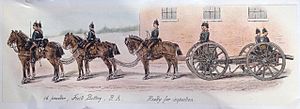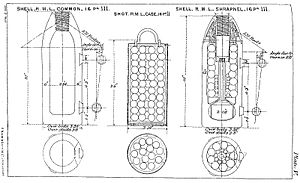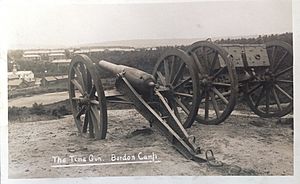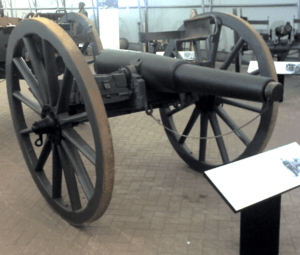RML 16-pounder 12 cwt facts for kids
Quick facts for kids RML 16-pounder 12 cwt gun |
|
|---|---|
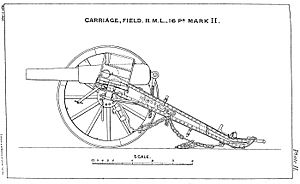
Gun on Mark II carriage
|
|
| Type | Field gun |
| Place of origin | United Kingdom |
| Service history | |
| In service | 1871–1908 |
| Used by | British Empire |
| Production history | |
| Designer | Woolwich Arsenal |
| Manufacturer | Woolwich Arsenal |
| Variants | 16 pdr 12 cwt Mark I (Land Service) only |
| Specifications | |
| Mass | 12-long-hundredweight (600 kg) |
| Crew | 9 |
|
|
|
| Shell | 16 pounds (7.3 kg) (common shell) 16 pounds (7.3 kg) (shrapnel) |
| Calibre | 3.6 inches (91 mm) |
| Action | RML |
| Breech | none – muzzle-loading |
| Muzzle velocity | 1,330 feet per second (405 m/s) |
| Effective firing range | 3,500 yards (3,200 m) |
The RML 16-pounder 12 cwt gun was a powerful British artillery gun from the 1800s. It was a "Rifled, Muzzle Loading" (RML) gun, meaning it had special grooves inside the barrel and was loaded from the front. This gun fired a projectile that weighed about 16 pounds (7.3 kg). The "12 cwt" part of its name tells you how much the gun itself weighed.
Contents
How the Gun Was Made
This gun was built from very strong materials. It had an inner tube made of tough steel. An outer tube of wrought iron was shrunk over it. This made the gun barrel very strong and durable.
The inside of the barrel had special spiral grooves. This feature is called rifling. It was designed by a person named William Palliser. When a shell was fired, small bumps on its sides would fit into these grooves. This made the shell spin as it left the barrel. Spinning helped the shell fly straight and hit its target more accurately.
The gun had sights on both sides of the barrel. These sights helped the crew aim the gun. They could aim directly at a target or use indirect aiming. There was also a flat spot on top of the barrel. A tool called a clinometer could be placed there. This tool helped the crew make sure the gun was level. It also offered another way to aim indirectly.
This gun was made only for use on land. There were no versions for ships. Two slightly different types of carriages were made for the gun.
How the Gun Was Used
The 16-pounder guns were usually used in groups called "batteries." A battery would have either six or four guns. Each gun needed a team of six horses to pull it.
A crew of nine people operated each gun. Five crew members could ride on seats on the gun's front part (the limber) and on the gun itself. Three other people were drivers for the horses. The gun commander, called "number one," rode separately.
Besides the gun, a special trailer carried ammunition. This trailer was also pulled by horses. Field Artillery, like this gun, was designed to move at the same speed as foot soldiers. Horse Artillery units, which used lighter guns, could move much faster when needed.
Ammunition for the Gun
The 16-pounder gun could fire three main types of ammunition:
- Common shell: This was used to attack buildings or strong defenses.
- Shrapnel shell: This shell was filled with small balls. It was used against groups of enemy soldiers or cavalry (soldiers on horseback).
- Case shot: This was used for very close-range fighting. It was effective against "soft targets," like enemy troops very near the gun.
To fire the gun, a special copper tube was put into a small hole at the back of the barrel. This tube was called a friction tube. A rope (lanyard) was attached to it. When the crew pulled the lanyard, the tube would light up. This would ignite the gunpowder inside the gun, firing the shell.
Different types of fuses could be used with the shells. Some fuses made the shell explode after a certain amount of time or distance. Others made it explode when it hit something.
The guns were fired using a silk bag filled with black powder. This powder was the propellant that pushed the shell out. A skilled crew could fire about one round per minute.
Where and When It Was Used
The 16-pounder 12 cwt Rifled Muzzle Loader became the main field gun for the British Royal Artillery in 1871. It replaced an older gun that was not very reliable.
This gun was used in several important conflicts:
- The Anglo-Zulu War in 1879.
- The First Boer War in 1881.
- The Anglo-Egyptian War in 1882, where four groups of these guns were used.
The 16-pounder stayed in active service with the Royal Artillery until the late 1880s. It was then replaced by a newer type of gun that loaded from the back.
Many of these guns were given to volunteer artillery groups starting in 1889. By 1893, a plan showed that 37 volunteer artillery groups had 16-pounder guns. These groups would gather in specific areas if there was a need to defend the country. Most of these guns were used until 1902. Some were still in use as late as 1908.
Some 16-pounder guns were also sent to different parts of the British Empire. For example, eight guns went to South Australia. Six guns were sent to the Trinidad Artillery Volunteers in the 1890s.
Guns You Can Still See Today
You can still see some of these historic guns in museums and parks today:
- Serial number 110 (made in 1872) is at the National Army Museum in the United Kingdom.
- Serial number 171 (made in 1873) is at Fort Nelson, Hampshire, part of the Royal Armouries Collection.
- Serial number 241 (made in 1877) is at Victoria Barracks, Sydney, Australia.
- Serial number 253 (made in 1878) is at the War Memorial, Coonooer bridge, Victoria, Australia.
- Serial number 285 (made in 1878) is at Fort Glanville Conservation Park, South Australia.
- Serial number 288 (made in 1878) is at the Army Museum of South Australia, Adelaide, South Australia.
- Serial number 289 (made in 1879) is also at Fort Nelson, Hampshire, part of the Royal Armouries Collection.
- Another example can be found at Fort Brockhurst, Gosport, United Kingdom.
See also



